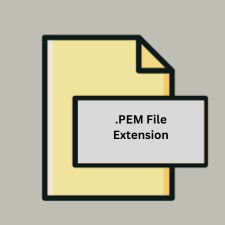.PEM File Extension

What is an PEM file?
A .pem file is a type of file used primarily for storing cryptographic keys, certificates, and other data related to secure communications. The term “PEM” stands for Privacy Enhanced Mail, which is an email standard that was designed to support secure email communications. Despite its origins, PEM files are now widely used beyond email for various security-related purposes.
More Information.
PEM was initially developed to enhance email security by encrypting and signing email messages. Over time, its use expanded to include a broader range of cryptographic functions, including the storage and exchange of digital certificates and private keys. PEM files are now used in various security protocols, including SSL/TLS for web security.
Origin Of This File.
The .pem format originated with the Privacy Enhanced Mail (PEM) standard, which was introduced in the 1990s by the Internet Engineering Task Force (IETF). PEM was intended to provide a framework for secure email and digital certificates.
File Structure Technical Specification.
- Encoding: PEM files use Base64 encoding to represent binary data in ASCII text format. This makes them easier to handle in text-based systems.
- Headers and Footers: PEM files typically include headers and footers that identify the type of data contained within.
How to Convert the File?
Windows
To convert PEM files on Windows, you typically need to use specialized software or command-line tools like OpenSSL:
- Using OpenSSL:
- Download and Install OpenSSL: First, you need to install OpenSSL on your Windows system. You can find installers for OpenSSL on various websites.
- Open Command Prompt: Open a Command Prompt window.
- Run Conversion Commands: Use OpenSSL commands to convert PEM files to other formats. For example, to convert a PEM certificate to DER format, you would use OpenSSL commands.
- Using Certificate Manager:
- Import and Export: For some conversions, you might import PEM files into Windows Certificate Manager and export them in different formats such as DER or PFX. This involves using the MMC (Microsoft Management Console) to manage certificates.
Linux
On Linux, converting PEM files is commonly done using command-line tools:
- Using OpenSSL:
- Install OpenSSL: OpenSSL is usually pre-installed on most Linux distributions. If not, you can install it using your package manager.
- Open Terminal: Launch a terminal window.
- Run Conversion Commands: Use OpenSSL commands to convert PEM files into other formats. OpenSSL handles various conversions, including PEM to DER, PEM to PFX, and more.
- Graphical Tools:
- CertTool: Some Linux distributions provide graphical tools for certificate management, but they may not support all conversions directly. You might need to use command-line tools for comprehensive conversions.
macOS
On macOS, you can use both command-line tools and built-in utilities:
- Using OpenSSL:
- Install OpenSSL: OpenSSL can be installed via Homebrew or is available in some macOS versions.
- Open Terminal: Launch the Terminal application.
- Run Conversion Commands: Use OpenSSL commands to convert PEM files into other formats, such as DER or PFX.
- Using Keychain Access:
- Import PEM Files: Open Keychain Access and import the PEM file.
- Export to Other Formats: Once imported, you can export the certificate in different formats like .CER or .P12 through the Keychain Access interface.
Android
On Android, conversions typically involve using apps or programmatic approaches:
- Using Apps:
- Install Certificate Management Apps: There are apps available on the Google Play Store that can handle PEM files, including converting them to other formats like DER.
- Follow App Instructions: Use the app’s built-in features to convert or manage PEM files.
- Programmatically:
- Custom Applications: Developers can use libraries like BouncyCastle within custom Android applications to perform conversions programmatically.
iOS
On iOS, conversions generally involve using apps or programmatic methods:
- Using Apps:
- Install Certificate Management Apps: Look for apps on the App Store that support certificate management and conversion.
- Use App Features: Follow the app’s instructions to import and convert PEM files as needed.
- Programmatically:
- Custom Development: Developers can use iOS frameworks such as the Security framework to handle and convert PEM files within custom iOS apps.
Others
For other systems or environments:
- Web-Based Tools:
- Online Conversion Tools: There are online services that allow you to upload a PEM file and convert it to other formats. Ensure the tool is reputable to avoid security risks.
- Text Editors and Utilities:
- Simple Conversion: For basic operations, you can manually copy and adjust the Base64-encoded content if needed. This approach requires caution to ensure that the file structure remains intact.
Advantages And Disadvantages.
Advantages:
- Interoperability: PEM files are widely supported across different platforms and applications.
- Text-based Format: Being text-based, PEM files are easy to handle and transfer through text-based systems.
- Human-readable: The Base64 encoding makes the file readable to some extent, allowing for easier inspection and debugging.
Disadvantages:
- Security: PEM files are text-based and can be easily read if not properly protected, which might expose sensitive information if not secured correctly.
- File Size: Base64 encoding increases the size of the file compared to its binary counterpart.
How to Open PEM?
Open In Windows
- Using OpenSSL: Install OpenSSL and use the command line to open or convert PEM files.
- Using Certificate Manager: PEM files can be imported into Windows Certificate Manager, but they may need conversion to .CER or .CRT format first.
Open In Linux
- Using OpenSSL: OpenSSL is commonly available on Linux distributions and can be used to view or convert PEM files.
- Command Line: You can use commands like
cat,openssl, andlessto view and manage PEM files.
Open In MAC
- Using OpenSSL: OpenSSL is also available on macOS, allowing you to work with PEM files similarly to Linux.
- Keychain Access: PEM files can be imported into macOS Keychain Access for managing certificates.
Open In Android
- Using Apps: Apps like “Certificate Installer” or “OpenSSL for Android” can handle PEM files.
- Programmatically: Custom applications can use libraries like BouncyCastle to manage PEM files programmatically.
Open In IOS
- Using Apps: Certificate management apps from the App Store can handle PEM files.
- Programmatically: Libraries such as Apple’s Security framework or third-party libraries can be used in iOS apps to work with PEM files.
Open in Others
- Web Browsers: Browsers may not directly handle PEM files but can import converted formats like .CRT or .PFX for SSL/TLS certificates.
- Text Editors: Since PEM files are text-based, they can be opened with any text editor (e.g., Notepad, TextEdit).













